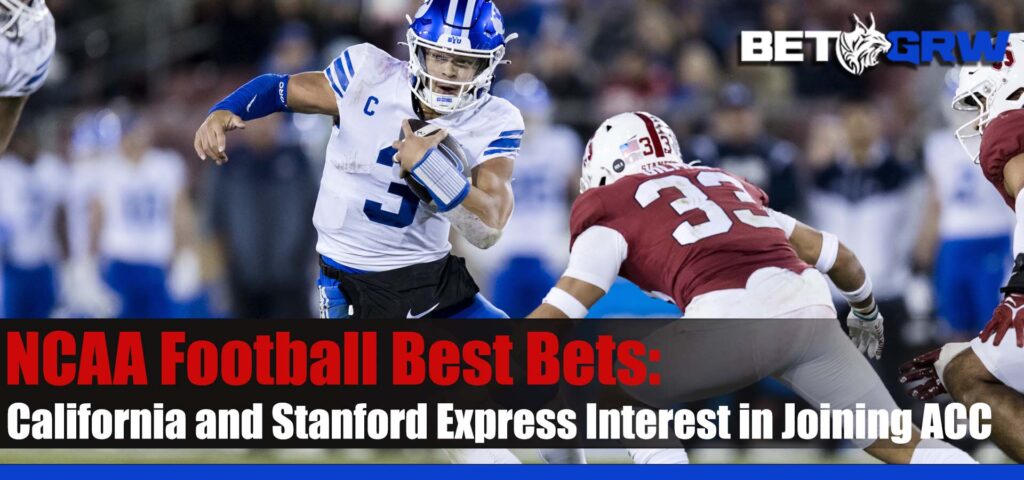
California and Stanford Express Interest in Joining ACC: Industry sources have recently reported a startling development in college sports picks: Cal and Stanford are interested in joining the Atlantic Coast Conference (ACC). Such an announcement could have far-reaching ramifications for both universities and college sports more broadly; as the ACC prepares to evaluate whether adding Pac-12 teams would be viable, let’s investigate what factors have led them to consider joining and any challenges this move could present.
The Evolving Landscape of College Sports
College sports have undergone dramatic realignment over the last several years as conferences strive to secure lucrative media rights deals and partner with prestigious institutions. Oregon, Washington, Arizona State University, and Utah’s departure from Pac-12 for Big Ten and Big 12 was a turning point in conference dynamics, leaving remaining Pac-12 schools, including Cal and Stanford, uncertain of their place in today’s ever-evolving college sports landscape.
California and Stanford Express Interest in Joining ACC: Why the ACC?
The Atlantic Coast Conference (ACC) is one of college athletics’ major power conferences, featuring elite football and basketball programs. However, media rights revenue lags behind Big Ten and SEC conferences; adding Cal and Stanford may help raise its average annual value (AAV) contract with ESPN and boost media rights revenue further.
Seeking Enhanced Prominence: Cal and Stanford would bring academic prestige and cultural resonance to the Atlantic Coast Conference (ACC). Six of its 15 schools – including Notre Dame – are already members of this esteemed American Association of Universities (AAU), adding academic credibility and cultural harmony. Their membership could strengthen ACC’s overall standing.
Addressing Revenue Disparities: Currently, the ACC media rights deal provides each school with $30 million per school, significantly lower than what the Big 12 ($31.7 million) offers and significantly less than what Big Ten and SEC do. Cal and Stanford joining might help ease concerns among member schools such as Clemson, Florida State, and Miami, who may feel unsatisfied with their revenue shares.
Filling the Void: Cal and Stanford have identified an opportunity with the Atlantic Coast Conference (ACC), offering them the chance to compete in an established conference with ample media exposure.
Why not the ACC?
Although Cal and Stanford could join the Atlantic Coast Conference (ACC), joining may present both schools with potential advantages and challenges that require careful consideration.
Geographical Constraints: As the Atlantic Coast Conference (ACC) primarily comprises East Coast schools, adding schools from California and Stanford would create logistical difficulties and increase travel expenses significantly; one possible flight route from there to Louisville – one current member school of the ACC – would span nearly 2000 miles.
Stanford’s Independent Status: Stanford, an esteemed private university, has recently been speculated to explore independent status. Such an action could affect Olympic sports programs that have performed consistently well at Stanford; financial support from significant conferences could present new obstacles for Stanford Athletic Department.
Potential Impact on Other Conferences: Cal and Stanford’s potential move to the ACC could create a ripple effect in other conferences. The Pac-12, already facing significant realignment, might lose more schools, which could further diminish its standing among power conferences.
Exploring the Financial Implications: Financial considerations are vital in any conference realignment decision. Shifting from one conference to another can profoundly affect an institution’s athletic department, revenue streams, and financial stability.
Stanford’s Unique Financial Situation: Stanford Athletic Department does not need to disclose financial information due to being a private institution; however, lacking support from major West Coast conferences could prove particularly troubling. Stanford attempted to cut 11 varsity sports during the pandemic but reversed its decision after backlash; joining another power league such as ACC could significantly boost Stanford, though these conferences still lag behind Big Ten and SEC in media rights revenue generation.
Impact on California Athletics: Cal, or University of California Berkeley as it’s widely known, boasts several Olympic-caliber sports teams that excel. Joining the Atlantic Coast Conference could give these teams new opportunities for high-level competition. At the same time requiring careful financial planning to accommodate increased travel expenses and logistical hurdles.
What about Oregon State and Washington State?
As the Pac-12 has undergone significant realignment with Oregon, Washington, Arizona State University, Utah, and Oregon opting for Big Ten or Big 12 conferences, respectively, remaining schools like Cal and Stanford have begun exploring alternative pathways.
Considerations for OSU and WSU: Oregon State and Washington State, historically part of the Pac-12 Conference, faced financial issues that put them behind other teams in their conference. Their financial metrics and institutional support have lagged, leaving them susceptible to being excluded from major college football games for long.
Potential Realignment in Other Conferences: OSU and WSU have also been considered potential participants in Mountain West and American conferences; however, joining such non-power conferences could have serious financial repercussions for these institutions.
California and Stanford’s decision to seek membership in the Atlantic Coast Conference (ACC) represents an extraordinary and noteworthy development in college sports news in Canada. This move brings exciting possibilities, yet it comes with its own set of challenges – both geographically and financially. Integration of Pac-12 teams into the ACC requires careful evaluation by all concerned. College sports fans eagerly anticipate further progress, knowing that this realignment could dramatically affect collegiate athletics. By embarking on this potential journey together, the ACC and West Coast institutions hold the potential to create an unprecedented chapter in college sports history.














